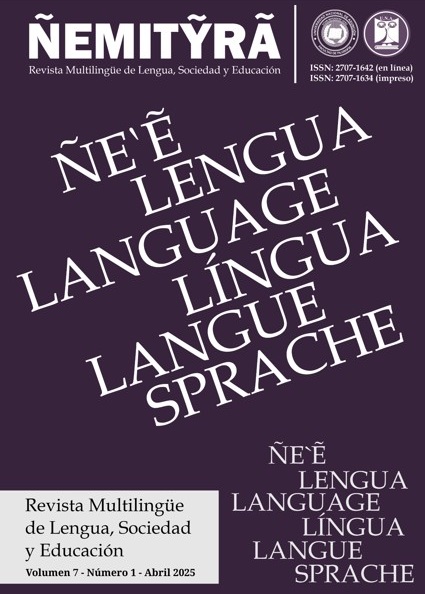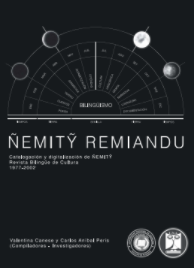La documentación de las lenguas indígenas del Paraguay en el marco del Decenio Internacional de las Lenguas Indígenas
DOI:
https://doi.org/10.47133/NEMITYRA20250101c-A10Palabras clave:
bilingüismo, documentación lingüística, lenguas chaqueñas, lenguas en peligro, lingüística históricaResumen
En esta breve contribución se resumen algunos de los temas tratados durante la conferencia de apertura de las V Jornadas de Lengua y Literatura realizadas en la Universidad Nacional de Itapúa en 2023. Después de haber dado una breve visión general de las lenguas en peligro (§1), se hablará de la extinción lingüística ocurrida en Paraguay en el pasado (§2) y se reflexionará sobre las razones por las que es necesario documentar (y si es posible revitalizar) las lenguas indígenas (§3), en particular, se mostrará lo que perdemos con la desaparición de una lengua y las ventajas para las comunidades que mantienen su lengua tradicional. Se concluirá con un breve recuerdo de Hannes Kalisch, un estudioso muy activo en la documentación de la familia enlhet-enenlhet (§4).
Referencias
Aikhenvald, A. Y. (2012). The languages of the Amazon. Oxford University Press.
Bertinetto, P. M., y Ciucci, L. (2012). Parataxis, hypotaxis and para-hypotaxis in the Zamucoan languages. Linguistic Discovery, 10(1), 89-111.
Bertinetto, P. M., Ciucci, L., y Farina, M. (2019). Two types of morphologically expressed non-verbal predication. Studies in Language, 43(1), 120-194.
Bilingualism Matters. (s.f.). We believe bilingualism matters. https://www.bilingualism-matters.org/
Boggiani, G. (1895). I Caduvei (Mbayá o Guaycurú). Viaggi d'un artista nell'America meridionale. Ermanno Loescher.
Cámara-Leret, R., y Bascompte, J. (2021). Language extinction triggers the loss of unique medicinal knowledge. PNAS, 118(24), Artículo e2103683118. https://doi.org/10.1073/pnas.2103683118
Campbell, L. (2012). Classification of the Indigenous languages of South America. En L. Campbell y V. Grondona (Eds.), The Indigenous languages of South America: A comprehensive guide (pp. 59-166). De Gruyter.
Campbell, L., y Grondona, V. (2012). Languages of the Chaco and Southern Cone. En L. Campbell y V. Grondona (Eds.), The Indigenous languages of South America: A comprehensive guide (pp. 625-668). De Gruyter.
Chomé, I. (1958). Arte de la lengua Zamuca [Manuscrito original ante 1745]. Présentation de Suzanne Lussagnet. Journal de la Société des Américanistes de Paris, 47, 121-178.
Ciucci, L. (2016). Inflectional morphology in the Zamucoan languages. CEADUC.
Ciucci, L. (2018). Lexicography in the eighteenth-century Gran Chaco: The Old Zamuco dictionary by Ignace Chomé. En J. Čibej, V. Gorjanc, I. Kosem y S. Krek (Eds.), Proceedings of the XVIII EURALEX International Congress: Lexicography in Global Contexts (pp. 439-451). Ljubljana University Press.
Ciucci, L. (2020). Matter borrowing, pattern borrowing and typological rarities in the Gran Chaco of South America. Morphology, 30(4), 283-310.
Ciucci, L. (2021a). From fieldwork to reconstruction: Historical issues in hotspots of linguistic diversity. Studia Linguistica, 75(2), 165-174.
Ciucci, L. (2021b). How historical data complement fieldwork: New diachronic perspectives on Zamucoan verb inflection. Studia Linguistica, 75(2), 289-327.
Ciucci, L. (2021c). How grammar and culture interact in Zamucoan. En A. Y. Aikhenvald, R. W. M. Dixon y N. Jarkey (Eds.), The integration of language and society: A cross-linguistic typology (pp. 235-287). Oxford University Press.
Ciucci, L. (2021d). Zamucoan ethnonymy in the 18th century and the etymology of «Ayoreo». Journal de la Société des Américanistes, 107(2), 77-114.
Combès, I. (2009). Zamucos. Instituto de Misionología.
Comrie, B., Golluscio, L. A., González H., y Vidal, A. (2010). El Chaco como área lingüística. En Z. Estrada Fernández y R. Arzápalo Marín (Eds.), Estudios de lenguas amerindias 2. Contribuciones al estudio de las lenguas originarias de América (pp. 85-131). Editorial Unison.
Crevels, M. (2002). Why speakers shift and languages die: An account of language death in Amazonian Bolivia. En M. Crevels, S. van de Kerke, S. Meira y H. van der Voort (Eds.), Current studies on South American Languages (pp. 9-30). CNWS.
Crevels, M. (2012). Language endangerment in South America: The clock is ticking. En L. Campbell y V. Grondona (Eds.), The Indigenous languages of South America: A comprehensive guide (pp. 167-233). De Gruyter.
Crystal, D. (2000). Language death. Cambridge University Press.
De Graaf, T. (2023). Use of historical material for the safeguarding of endangered languages. En E. Derhemi y C. Moseley (Eds.), Endangered languages in the 21st century (pp. 126-138). Routledge.
Derhemi, E., y Moseley, C. (Eds.). (2023). Endangered languages in the 21st century. Routledge.
Eberhard, D. M., Simons, G. F., y Fennig, C. D. (Eds.). (2023). Ethnologue: Languages of the World (26ª ed.). SIL International. http://www.ethnologue.com
Fabre, A. (2007-2023). Diccionario etnolingüístico y guía bibliográfica de los pueblos indígenas sudamericanos. http://www.ling.fi/DICCIONARIO.htm
Garraffa, M., Obregon, M., y Sorace, A. (2017). Linguistic and cognitive effects of bilingualism with regional minority languages: A study of Sardinian-Italian adult speakers. Frontiers in Psychology, 8. https://doi.org/10.3389/fpsyg.2017.01907
Greenberg, J. H. (1987). Language in the Americas. Stanford University Press.
Grinevald, C. (2003). Speakers and documentation of endangered languages. En P. K. Austin (Ed.), Language documentation and description (Vol. 1, pp. 52-72). Hans Rausing Endangered Languages Project.
Hale, K., Krauss, M., Watahomigie, L. J., Yamamoto, A. Y., Craig, C., Jeanne, L. M., y England, N. C. (1992). Endangered languages. Language, 68(1), 1-42.
Hallett, D., Chandler, M. J., y Lalonde, C. E. (2007). Aboriginal language knowledge and youth suicide. Cognitive Development, 22(3), 392–399.
Hammarström, H., Forkel, R., Haspelmath, M., y Bank, S. (Eds.). (2023). Glottolog 4.8. Max Planck Institute for Evolutionary Anthropology. http://glottolog.org
Hervás y Panduro, L. (1787). Saggio pratico delle lingue. Gregorio Biasini.
Instituto Nacional de Estadística. (s.f.). Resultados Preliminares del Censo Nacional de Población y Viviendas 2022. https://www.ine.gov.py/censo2022/
Instituto Nengvaanemkeskama Nempayvaam Enlhet. (2023, 11 de agosto). Bibliografía completa. https://enlhet.org/bibliografia.html
Kalisch, H. (2023). Alhpeema vana. Las palabras de los guaná. Diccionario básico de la lengua guaná con traducciones al guaraní y al castellano. Nengvaanemkeskama Nempayvaam Enlhet y Secretaría de Políticas Lingüísticas.
Keysar, B., Hayakawa, S. L., y An, S. G. (2012). The foreign-language effect thinking in a foreign tongue reduces decision biases. Psychological Science, 23(6), 661-668.
Kovács, Á. M., y Mehler, J. (2009). Flexible learning of multiple speech structures in bilingual infants. Science, 325(5940), 611-612.
Krizman, J., Marian, V., Shook, A., Skoe E., y Kraus, N. (2012). Subcortical encoding of sound is enhanced in bilinguals and relates to executive function advantages. Proceedings of the National Academy of Sciences, 109(20), 7877-7881.
Loh, J., y Harmon, D. (2014). Biocultural diversity: Threatened species, endangered languages. WWF Netherlands.
Loukotka, Č. (1968). Classification of South American Indian languages. Latin American Studies Center, UCLA.
Lussagnet, S. (1961-1962). Vocabulaires Samuku, Morotoko, Poturero et Guarañoka précédés d'une étude historique et géographique sur les anciens Samuku du Chaco bolivien et leurs voisins. Journal de la Société des Américanistes de Paris, 50-51, 185-243 y 35-64.
Maffi, L. (Ed.). (2001). On biocultural diversity: Linking language, knowledge, and the environment. Smithsonian Institution Press.
Martínez, C. (2018). Una etnohistoria de Chiquitos. Más allá del horizonte jesuítico. Instituto Latinoamericano de Misionología e Itinerarios Editorial.
Mazzitelli, L. F. (2020). Documentation of Lakurumau: Making the case for one more language in Papua New Guinea. Language Documentation and Conservation, 14, 215-237.
Michael, L. (2021). The classification of South American languages. Annual Review of Linguistics, 7, 329-349.
Naciones Unidas. (2022, 17 de enero). Arranca la década para salvar de la desaparición a las lenguas indígenas. https://news.un.org/es/story/2022/01/1502682
Sánchez Labrador, J. F. (1970). Gramática de la lengua Eyiguayegi [Manuscrito original 1760]. Museo Etnográfico Andrés Barbero.
Sandalo, F. (1995). A grammar of Kadiwéu [Tesis doctoral]. University of Pittsburgh.
Schmidt, M. (1949). Los payaguá. Revista do Museu Paulista, nova série, 3, 129-269.
Secretaría de Políticas Lingüísticas. (s.f.). Lenguas indígenas. https://www.spl.gov.py/es/index.php/misional/lenguas-indigenas
Taff, A., Chee, M., Hall, J., Dulitseen Hall, M. Y., Martin, K. N., y Johnston, A. (2018). Indigenous language use impacts wellness. En K. L. Rehg y L. Campbell (Eds.), The Oxford handbook of endangered languages (pp. 862-883). Oxford University Press.
Viegas Barros, P. J. (2013). La hipótesis de parentesco guaicurú-mataguayo: estado actual de la cuestión. Revista Brasileira de Linguística Antropológica, 5(2), 293-333.
Zuckermann, G. (2020). Revivalistics: From the genesis of Israeli to language reclamation in Australia and beyond. Oxford University Press.
Descargas
Publicado
Número
Sección
Licencia
Derechos de autor 2025 Luca Ciucci y Revista Ñemitỹrã

Esta obra está bajo una licencia internacional Creative Commons Atribución 4.0.










